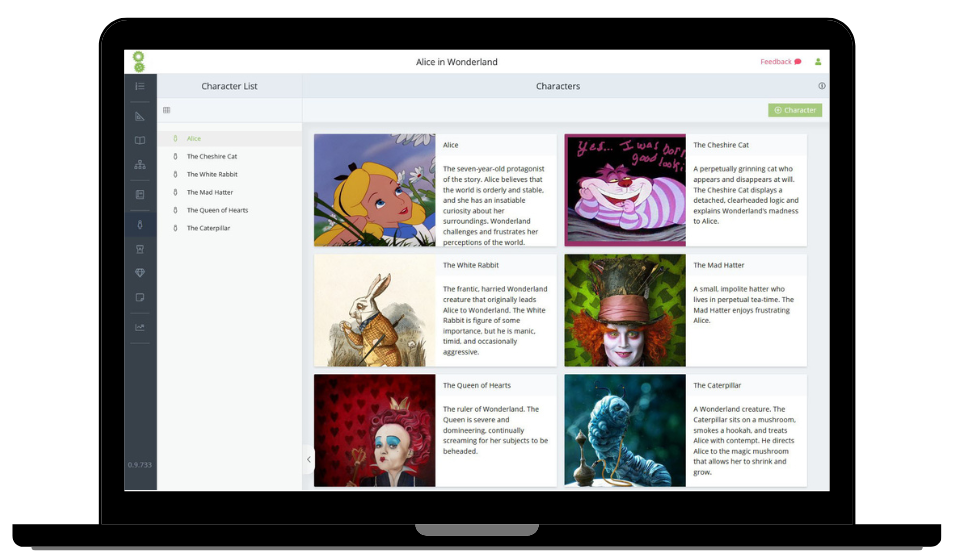
What Are Character Tropes and When Should You Use Them?
You’ve heard of character archetypes, but do you know about character tropes?
More specifically, do you know how to use them to write stronger stories?
Archetypes inform your characters and the roles they play in your novel, but tropes can help you round out your characters’ personalities.
Why you may already be using them without realizing it…
Once you understand character tropes and how to use them, you can trigger powerful associations for your readers—ones that let your characters jump off the page, either because they’re comfortingly familiar or because they’re wickedly surprising.
What are character tropes?

A trope is an idea, pattern or motif that appears often enough in a particular art form that consumers of that art form begin to form particular associations with that idea.
For example, the words ‘action hero’ will likely cause many images and preconceptions to appear in your mind. The image in your mind won’t be exactly the same as someone else’s, but the stronger the trope, the more solid and consistent the associations we create.
Skillful writers can take advantage of these preconceptions to swiftly build characters with few words, knowing that the readers will fill in the blanks. And by subverting the tropes, they can create surprise and intrigue.
While cliches are generally accepted to be ‘bad’ by definition, because they feel old and overused, tropes are neither good nor bad in themselves. They are tools—which can be used skillfully, or poorly.
Character tropes vs archetypes: What’s the Difference?
Archetypes refer more to a role, whereas tropes refer more to a personality.
So a ‘mentor’ archetype is a character who plays a role of guiding a main character. However, that mentor could be one of many different character tropes, from wizened elder to drunken cynic to uptight librarian (as in Harry Potter, The Hunger Games, Buffy the Vampire Slayer).
Likewise, another common archetype is the Ally or Sidekick, but this could be played by any kind of personality trope, from know-it-all geek to a comic donkey to a hopelessly-in-love nice guy (Harry Potter, Shrek, The Hunger Games).
Read more about archetypes here.
When should you use character tropes?
While cliches should be avoided, as they demonstrate a lack of originality, tropes are a tool that can be used to great effect – if done skillfully.
For example, character tropes are essential building blocks when it comes to Flat Characters.
While your main cast should be Round Characters, each with their own goals, fears, flaws and foibles, your novel will also be filled with Flat Characters, who exist to fulfill a particular small role. If you tried to make every single character Round, it would bloat and muddy the story unnecessarily.
Using tropes for Flat Characters, means you can create an image in your reader’s mind which has far more depth and detail than you’ve spent words on, as they will recognize the trope and fill in the gaps.
Also, tropes can be subverted to surprise readers in ways that delight and entertain, lifting a flat trope into a unique round character.
For example, you could have an ‘action hero’ who is actually a highly educated professor, such as Robert Langdon in the Dan Brown novels (albeit of a fictional subject), or you could have a ‘dumb jock’ who’s into poetry and gardening.
In fact, going against gender stereotypes of a trope is a good way to create something that feels fresh, and also help to rewrite the entrenched narratives of our society which can be limiting for all genders.
One way to get a sense of what tropes and stereotypes are prevalent in people’s minds is to enter the term into Google images and see what comes up.
If you enter ‘mad scientist’ the vast majority of the images are of elderly white men with crazy Albert Einstein style hair, often laughing maniacally and holding test tubes and conical flasks of colored liquids.
So you could subvert this by making the character female, non-white, neatly dressed and coiffed and possibly give them less cliched scientific props, such as astronomy or excavation equipment.
Note that you can subvert tropes by changing the character’s physical profile, as above, or giving them unexpected interests, skills or talents.
Bear in mind that if you change too many factors, then the character will no longer be recognizable as the trope, and you may lose any possible benefits of appealing to it.
Common Character Tropes & Examples

Some tropes should definitely be either subverted or avoided entirely, as they have either become so overused as to stray into cliche territory, or reinforce unhelpful stereotypes about gender, race or ability.
Avoid These Character Tropes
Femme Fatale
The femme fatale is a sexy lady who means trouble. Since Eve dared to take a bite of the apple, and mermaids sang from ocean rocks, alluring women have been portrayed as the downfall of noble, innocent men.
Unless you can invert this trope, perhaps by making a man the slinky seductor who uses his sex appeal to get things done, or by making the femme fatale actually so clumsy she often misses her mouth with her fork, this one is best left to the archives.
The Chosen One
There are two reasons not to use a Chosen One cliche. The first is that it’s been so overused it is yawn-inducingly cliche.
The other is that it sends a problematic message that you are either born a hero, or you’re not. This is much less motivating for individuals than the concept that your actions and decisions will decide what sort of person you are.
Damsel in Distress
Similarly to the femme fatale, women are tired of being portrayed as victims in need of rescuing, so unless your damsel in distress is actually going to turn out to be an undercover ninja who drop-kicks her attackers before the ‘hero’ can get in the door, or your damsel is actually a dude in distress, avoid this unhelpful stereotype.
Use these Character tropes for your flat characters
The Grumpy Receptionist
You know who I mean. The woman behind that high desk, who manages to look down on you, even as she’s looking up. She is the gatekeeper, she controls access to the one behind.
Using this trope means you tap into people’s experiences of having to deal with this person in real life, bringing up emotions of stress and frustration which you want to evoke in a scene where your character is experiencing the same thing. The grumpy receptionist will play no further part in the story, so she can stay flat, and infuriating.
The Oppressive Boss
It’s also possible to use an oppressive boss trope in order to pile pressure onto your main character. If the story revolves around a character’s work, then the boss should probably be a round character.
However, if the main character is trying to achieve something unrelated, but they need a little leeway from their day job, then having a boss that says no and won’t listen to reason can be a useful lever to add pressure.
The Empathetic Pet
Sometimes animals just seem to know. When your main character is feeling low, and all seems lost, a pet or stray will often nuzzle up for a hug. This can be a useful way to build empathy with a character, and if done well, have a heart-warming moment.
Subvert these character tropes to make great round characters
Action Hero
There’s a lot to like about the Action Hero. He’s usually dashing, proactive and skillful. Action Heroes are popular characters across many genres and can appeal to a wide range of readers. But people may be tired of the classic ex-military, gruff, stubbly man in his thirties.
Better to subvert at least some of the action hero stereotypes by making them female, eloquent, non-violent and / or sensitive to his feelings and those of the people around him (or her).
The Loving Mother
Mothers are loving, selfless, giving and patient, right? Yes. But they’re also under-resourced, tired, filled with self-doubt and constantly living under a black cloud of guilt.
If you can take a Loving Mother stereotype and subvert it, you could end up with a nuanced character with high stakes, that many people truly identify with.
The Dumb Muscle
This character is not usually a main character – but what if they were? What if we discovered that behind the single word answers and doglike obedience was a great mind that was biding its time?
What if the Dumb Muscle was actually top of their police training academy and has spent the last ten years acting dumb undercover while they carefully put all the pieces of their strategy in place, until they can finally overthrow the kingpin?
Or alternatively, what if the Dumb Muscle has a traumatic backstory that explains their single-mindedness and lack of empathy…
Are Your Characters Too Cliche?
If you find the idea of character tropes fascinating and want to learn more, then you could also visit the Characters section of TV Tropes, but beware, when the site declares itself as ‘all-devouring’, it’s not kidding.
Now that you’re more familiar with character tropes, and how they can be used, see which ones you can spot in the next books you read and TV shows and movies you watch. See how close to the stereotype they stick, and whether you find it satisfying or not.
Then take a look at your own characters and see where character tropes are coming up. Do you only use them for supporting stock characters? Or could your main characters be accused of being character cliches?
Here are a few more useful resources for learning more about common literary character tropes:
https://screencraft.org/2018/07/09/99-archetypes-and-stock-characters-screenwriters-can-mold/
Unlock your writing potential
If you liked this article by the Novel Factory, then why not try the Novel Factory app for writers?
It includes:
- Plot Templates
- Character Questionnaires
- Writing Guides
- Drag & Drop Plotting Tools
- World Building resources
- Much, much more

